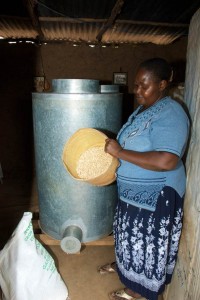The employment and income network of the Swiss Agency for Development and Cooperation SDC invited development practitioners to a 2 days seminar on social entrepreneurs and businesses in agriculture. The first day presented innovative examples from Switzerland and Germany. The second day looked at examples beyond Europe.
Innovative business approaches were presented by social entrepreneurs and social businesses. In this video, Peter Beez, focal point of the e+i network, explains how the two concepts fit into the SDC e+i vision.
To be more specific, here a concrete example from the SDC Postcosecha initiative:
In SDC partner countries in Africa, Latin America and Asia, rats, insects, chicken, and even moisture contribute to post harvest losses. Small farmers loose a considerable amount of their harvest due to inadequate storage facilities. Reducing post harvest losses also reduces the farmers’ vulnerability to food insecurity and increases their income. They can sell more of their produce.

Peter Beez, SDC e+i network
The Postcosecha project created metal storage silos that reduce usual storage looses of 10%-30% to 0%. To spread the use of these new silos SDC created a market for these silos. Tinsmiths were trained to produce the metal silos. They then sold the silos to smallholders and rural families.
SDC also built capacities of other actors to market the silos and to assure production quality. Today, several hundred thousand families use silos and have reduced their post-harvest losses. They can sell their produce when prices are high and can buy additional cereals when the price is low.
However, there are some flaws. Some functions the project provided have not been taken over by the market or the government: Quality control and capacity building are crucial aspects of the initiative that ceased to exist.

metal silo
The traditional way to fix this, is to find and fund appropriate players to fulfill the missing functions. However, SDC decided to try something new: The missing functions could be taken over by a social enterprise.
Social enterprises may be the ideal partners to solve distribution of products and services that improve the livelihood of the poor!
There are certain challenges that such a enterprise would have to tackle:
- The social mission is important. The poor do not benefit from economies of scale, i.e. bigger silos are cheaper but are bought by richer clients. Richer clients with surpluses or even speculators benefit more from their investment than subsistence farmers. The rich farmers can sell greater quantities of their produce when the prices are high.
- Making sure that low income households can buy silos, the marketing approach needs to be socially orientated. This represents an extra effort for the enterprise.
- The silo is just one useful technology designed for poverty reduction. In order to continue expanding, the enterprise would have to start looking into providing further services to farmers. The company needs to reinvent itself and innovate constantly in order to provide relevant solutions to its clients.
Currently, SDC is looking to find a social entrepreneur who would take up this challenge. This new actor would profit from SDC support in order to launch the enterprise. Who wants to take up this challenge ?!?
